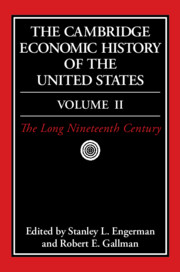Book contents
- Frontmatter
- 1 Economic Growth and Structural Change in the Long Nineteenth Century
- 2 The Economy of Canada in the Nineteenth Century
- 3 Inequality in the Nineteenth Century
- 4 The Population of the United States, 1790–1920
- 5 The Labor Force in the Nineteenth Century
- 6 The Farm, The Farmer, and The Market
- 7 Northern Agriculture and the Westward Movement
- 8 Slavery and its Consequences for the South in the Nineteenth Century
- 9 Technology and Industrialization, 1790–1914
- 10 Entrepreneurship, Business Organization, and Economic Concentration
- 11 Business Law and American Economic History
- 12 Experimental Federalism: the Economics of American Government, 1789–1914
- 13 Internal Transportation in the Nineteenth and Early Twentieth Centuries
- 14 Banking and Finance, 1789–1914
- 15 U.S. Foreign Trade and the Balance of Payments, 1800–1913
- 16 International Capital Movements, Domestic Capital Markets, and American Economic Growth, 1820–1914
- 17 The Social Implications of U.S. Economic Development
- Bibliographic Essays
- Index
- References
5 - The Labor Force in the Nineteenth Century
Published online by Cambridge University Press: 28 March 2008
- Frontmatter
- 1 Economic Growth and Structural Change in the Long Nineteenth Century
- 2 The Economy of Canada in the Nineteenth Century
- 3 Inequality in the Nineteenth Century
- 4 The Population of the United States, 1790–1920
- 5 The Labor Force in the Nineteenth Century
- 6 The Farm, The Farmer, and The Market
- 7 Northern Agriculture and the Westward Movement
- 8 Slavery and its Consequences for the South in the Nineteenth Century
- 9 Technology and Industrialization, 1790–1914
- 10 Entrepreneurship, Business Organization, and Economic Concentration
- 11 Business Law and American Economic History
- 12 Experimental Federalism: the Economics of American Government, 1789–1914
- 13 Internal Transportation in the Nineteenth and Early Twentieth Centuries
- 14 Banking and Finance, 1789–1914
- 15 U.S. Foreign Trade and the Balance of Payments, 1800–1913
- 16 International Capital Movements, Domestic Capital Markets, and American Economic Growth, 1820–1914
- 17 The Social Implications of U.S. Economic Development
- Bibliographic Essays
- Index
- References
Summary
American economic growth in the nineteenth century was the wonder of the Western world. Over the course of the century the growth rate of national product averaged 3.5 to 4.0 percent per year, far higher than in England or other European countries. Compared with the twentieth century, nineteenth-century American growth owed much more to increases in factor supplies than technological change. Of the three major productive inputs – labor, natural resources, and capital – increases in the supply of labor account for the largest fraction of aggregate growth in the nineteenth century: twice as important as capital accumulation, five times as important as additions to the stock of natural resources. If it is true that labor makes a nation’s wealth, few better examples could be found than the American economy of the nineteenth century.
This chapter surveys the major developments in the American labor force in the nineteenth century: its size and composition; rewards to labor; and labor relations, within firms and with the government. The scope of the chapter is deliberately wide, with an underlying emphasis on aspects of change important in the subsequent development of the labor force in the twentieth century. For example, I give considerable attention to trends in nonfarm wages because a majority of American workers in the late twentieth century are employed in nonfarm industries. In keeping with this theme, the chapter concludes with a snapshot view of labor markets at the turn of the twentieth century compared with labor markets today.
- Type
- Chapter
- Information
- The Cambridge Economic History of the United States , pp. 207 - 244Publisher: Cambridge University PressPrint publication year: 2000
References
- 15
- Cited by



